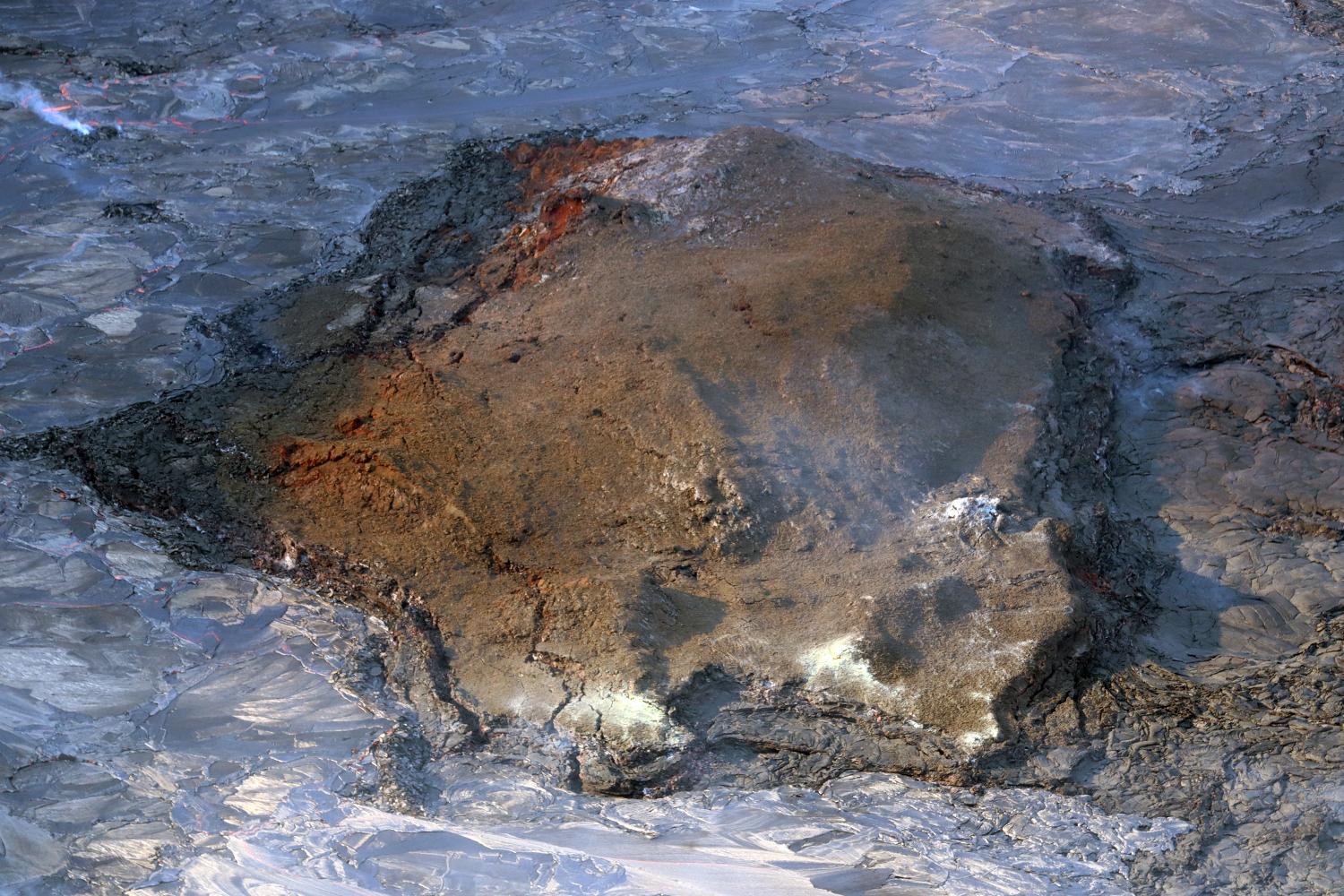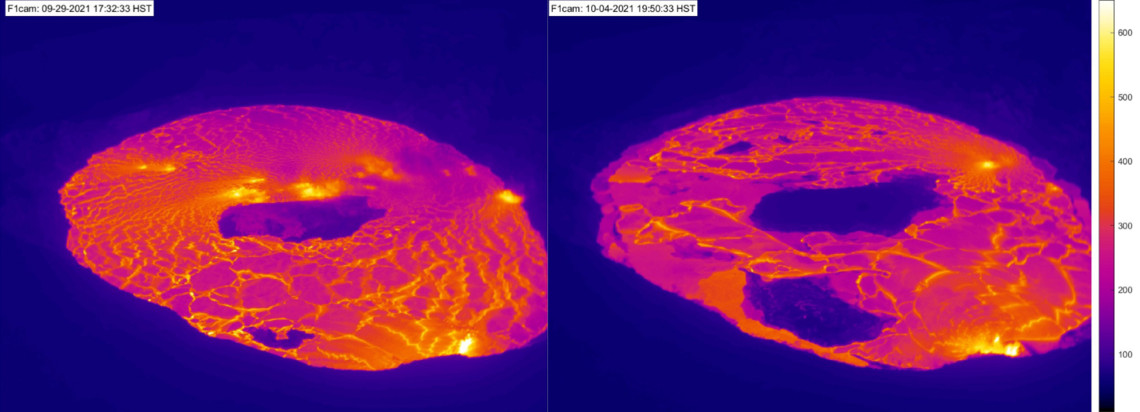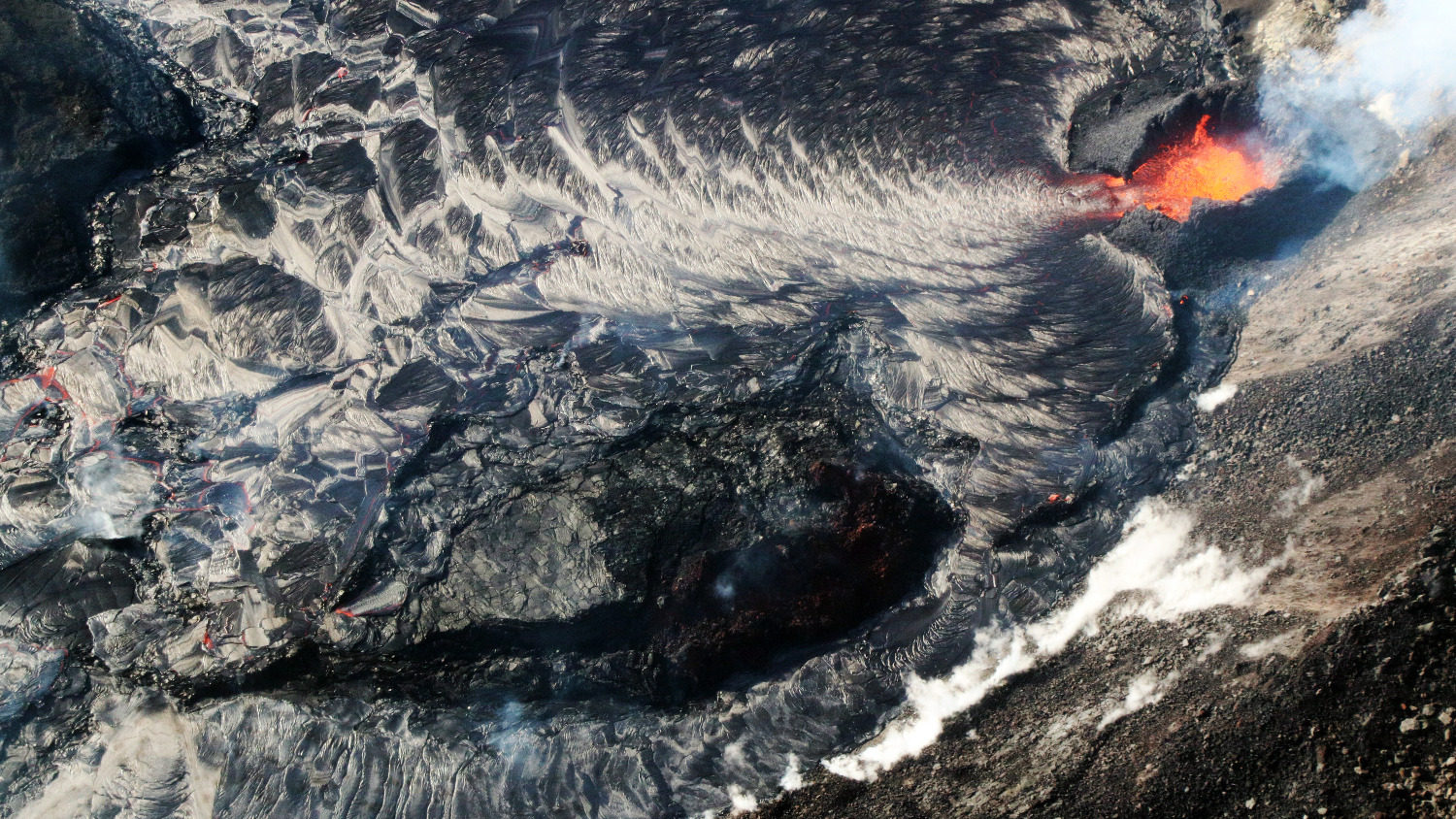
USGS: “Late afternoon sunlight illuminates the main island in the lava lake in Halema‘uma‘u crater, at the summit of Kīlauea. The island formed in the previous summit eruption (December 2020-May 2021), and was covered with fresh spatter during the opening stages of the current eruption.” (USGS photo by M. Patrick)
(BIVN) – The new eruption of Kilauea continues at the summit, and in this week’s Volcano Watch article, U.S. Geological Survey Hawaiian Volcano Observatory scientists and affiliates focus on the floating “islands” that can be seen in the Halemaʻumaʻu lava lake. From the USGS HVO:
The past year has seen fluctuating lava lakes, ephemeral lava fountains, craggy spires, and drifting “islands” reminiscent of pre-1924 Halemaʻumaʻu activity at the summit of Kīlauea. The recent activity has USGS Hawaiian Volcano Observatory (HVO) scientists reflecting on prior observations and how they compare to recent activity.
The last eruption of Halemaʻumaʻu began December 20, 2020, and created a lava lake at the base of the crater with striking topographic relief across its surface. Part of this relief formed the first night of the eruption.
A broad, high, light brown to tan feature—made up of less-dense material—appeared to be floating in the lava lake. Over the next week, it migrated around the lake based on flow directions from vents active at the time, eventually halting in the center of the lake.
HVO geologists found this feature to be reminiscent of the “floating islands” described by Kīlauea summit observers a century ago and earlier. As the eruption waned in intensity, more of these features formed in a variety of sizes and heights; all eventually became stationary. Contemporary geologists suggest that raft may be a better term to describe these features, which we continue to learn about with the new eruption at Kīlauea’s summit.
The current Halemaʻumaʻu eruption started at 3:21 p.m. HST on September 29, 2021, as lava fountains erupted from a north-south-trending crack in the crust of the December 2020-May 2021 lava lake surface. A thermal camera monitoring Halemaʻumaʻu documented the eruption start, showing a new lava lake rising rapidly and covering many of the island features formed during the previous eruption.
By the time geologists arrived for visual observations about an hour after this new eruption began, only the largest island, a small island to the northeast, and part of the high-standing west vent system from the December 2020 eruption remained above the surface of the new rising lava lake. Several hours later, the northeast island was submerged by lava and the highest point of the large central island was only 10 meters (33 ft) above the surface of the new lava lake.

USGS: “View looking down at the September-October 2021 lava lake eruption of Halemaʻumaʻu from the F1 thermal camera located on the western rim of the crater at Kīlauea’s summit. Molten material appears as warmer colors of yellow, orange, and pink, whereas cooler material is represented by dark blue and purple colors. The left-hand image is from September 29, 2021, at 5:32 p.m. HST and shows that the lava lake has essentially repaved the floor of the crater with the exception of the central raft and part of the old west vent system. The right-hand image is from October 4, 2021, at 7:50 p.m. HST with noticeably darker blue/purple rafts present throughout the eastern part of the lava lake and with both the central raft and old western vent system having more exposed area.” (USGS images)
It seemed apparent that the newly forming lava lake was going to continue rising and eventually cover all remnant topography of the earlier eruption. However, as the eruption progressed, the height of the large island above the lava lake surface started to increase. Islands that geologists saw being submerged in new lava soon also started to reappear.
The smaller island in the northeast part of the lava lake—that was submerged at around 5:20 p.m. HST—reappeared a little over an hour later. Over the next few days, more islands within the eastern and northern part of the lava lake would re-emerge above the lava lake surface. The largest island now has a high point that is 20 meters (66 ft) above the active surface of the lava lake.
It’s unclear why these islands – or rafts – that were only a few days ago submerged by the lava lake have reappeared. The recently cooled and solidified crust of lava erupted during the December 2020–May 2021 eruption seems to be buoyant in a way that is allowing for it to gradually float up within the new molten lava erupted in the past week.
It seems unlikely that these are individual pieces of crust detaching from the old, solidified lava lake floor and rising up. If that were the case, at least some of the smaller island would then migrate around the lava lake as lava flows moving outward from the active vents push them around. All of the islands appear to be stationary except for floating vertically upward so it’s likely that all or large chunks of the older lava lake floor are moving upward together.
Similar lava lake behavior was observed by Thomas A. Jaggar, founder of HVO, about a century ago. However, Halemaʻumaʻu crater was much smaller then, about a one-fifth or twenty percent of its size today. Detailed documentation of activity at Kīlauea over the past century allows for these observations, made decades apart, to be compared. As lava lakes rise and fall, so, too, do islands or rafts!


by Big Island Video News8:24 am
on at
STORY SUMMARY
HAWAIʻI VOLCANOES NATIONAL PARK - Geologists compare the floating islands found in the Halemaʻumaʻu lava lake to those described by observers a century ago.